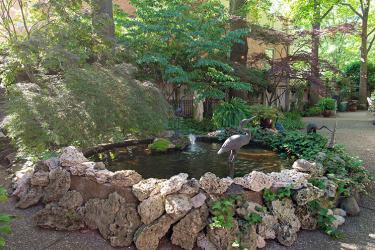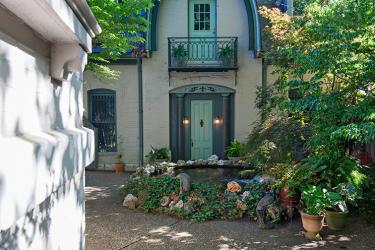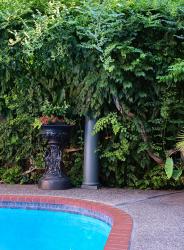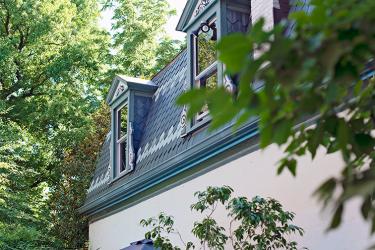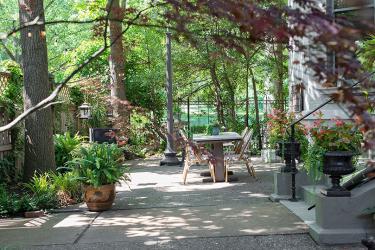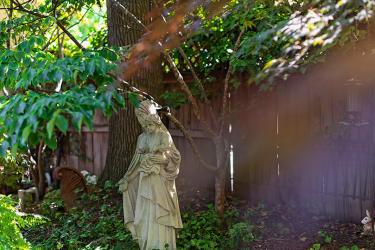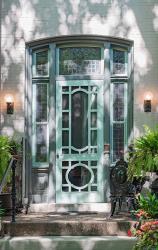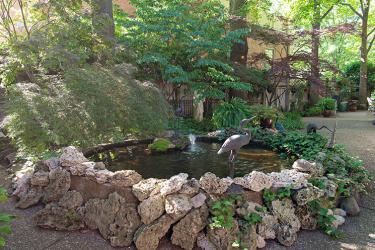Wealthy Victorians collected things. Taking advantage of improved transportation via railroads and steamships, they traveled far and brought back beautiful objects. Their homes showcased the paintings, elaborate furniture and decorative accessories they purchased on their journeys. They also accumulated classical statues and what they considered exotic plants, often tropicals, which they incorporated into their outdoor spaces in an attempt to recreate the wonders they had seen on their wanderings.
St. Louis’s Lafayette Square, centered with a 30-acre park dating to 1851, is nationally recognized for its display of beautifully restored, Second-Empire-style Victorian homes. Carolyn and Mike McAvoy have called Lafayette Square home since 1974. “We fell in love with the neighborhood because of the architecture, the history and the park,” Carolyn explains. “Once we moved in we fell in love with the community. It is a very tight-knit neighborhood; like living in a small town within a big city.”
In 1983, they bought their current three-story, 1885 townhome with its classic mansard roof shortly after it had been damaged in a devastating fire. Their goal; to restore it to its Victorian glory. “It took about three years to get the house to where we could live in it,” Carolyn recalls. “We bought it several months after our son was born and he was three when we moved in.”
Their first house had no greenspace at all, so Carolyn was delighted with the new property, which offered a front, side and back yard, where there was an existing swimming pool. “I’m a transplanted Iowa girl,” she says. “I grew up with gardens and flowers. Now, I had a big patio and a swimming pool. I like gardening so much that we actually thought about filling up the swimming pool with dirt to create more space for a garden.”
Ultimately, the pool stayed, and Carolyn began working with the three spaces, which she notes have different climates due to the surrounding buildings and walls. The fire had destroyed much of the low- growing vegetation, so some areas were a blank canvas. “We planted a lot of the trees and some of them that were already there were babies,” Carolyn says. “Now we have these fabulous mature trees and we’ve gone from having a lot of sun to having a lot of shade.”
Large pin oaks grace the small front yard that is framed with a perennially green boxwood hedge. Two delicate Japanese maple trees flank the entrance to the house and contrast beautifully with the massive, double front doors.
Carolyn’s gardening creativity truly begins at the back of the house where she nurtured the tiny trumpet vines she found there and created a trellis to conceal the fence that backed the pool. Full and lush, the vines now form a 10-foot-tall, leafy wall that makes the pool appear as if it has been dropped into a verdant oasis. “The vines have been here for 48 years,” she notes. “In the beginning they did not look at all like they do now. It is lovely to live in a place where you can envision that happening.” To further enhance the garden-like ambiance, Carolyn employs planters filled with palms and ficus trees. With a nod to the Victorian period of her home, classical statues of Neptune and Venus watch over one end of the space and a joyous statue of a water nymph accents the other. The nymph is a copy of the statue made for the entrance to Pasadena Hills by St. Louis’s Zymo Studios. “The back yard is lush and gorgeous about five months a year and then we put the cover on the pool and we don’t go back here,” Carolyn says. As part of that process, “we get the dollies out and roll the planters into a pickup truck and store them in a building we own,” she says.
The elaborate, art-glass-accented east entrance to the house once served visitors who arrived by coach and provided access to the carriage house at the back of the property. With the horses and carriages long gone and the building now used for a three-car garage and storage, Carolyn transformed the east entrance into a gathering space surrounded by beautiful vegetation. Dominated by large sweetgum trees, she added smaller, understory trees such as lacy, red-leaved Japanese maples and native dogwoods. An upright circular fishpond was already in existence. To tie that concrete structure to the landscape, the couple surrounded it with the decorative, porous limestone rock typically used in rock gardens of the period.
Because the space is sandwiched between the limestone façade and brick walls of her home and the brick wall of the house next door, Carolyn relies on multiple plant-filled containers of varying heights and statuary to create a lush courtyard. Ferns and begonias add color and texture. A tall but airy wrought-iron fence on the south side of the courtyard allows views of the park across the street to become part of the landscape. Marble-topped tables and wicker and wrought-iron chairs provide a welcoming invitation to relax and visit. “It is a delightful place all year long,” Carolyn says. “It is a fun place to simply sit and read a book.”
Carolyn and Mike have accumulated planters and statuary from a variety of places; like the Victorians they are collectors. “We’re scavengers,” she explains with a smile. “We enjoy collecting things and we go to a lot of auctions and estate sales. We’ve been doing it ever since we’ve lived here. I know when I see something I want, I need to buy it. I won’t see it again.”
The architecture of the brick carriage house and even the screen door to the entrance to the main house all play a role in the historic authenticity of the courtyard. They sought out and purchased the period screen door from a reproduction firm in Texas. Working with old photographs, the McAvoys have added trim to the carriage house windows and chimney pots to the slate roof to mimic the original design of the lovely, two-story building. The upper level once contained servants’ quarters as well as a hayloft.
“We are trying to put things back the way they were,” Carolyn explains. “We are very careful about making things look like they have always been there. My husband is a maniac about making sure everything is perfect, even if it is something the average person doesn’t see.”
Carolyn is careful about saving everything from stone blocks to old bricks that were once part of the home. “I save everything just in case,” she says with a laugh. “Pretty often I find something to do with it.”
She has found great satisfaction in adding greenery to the bricks and mortar of her historic home. “The park was heavily landscaped,” she points out. “But the landscaping around the individual homes was sparce. I think the way we have our yard would have been true to those principles. “I love having the freedom to create a space and do things that make me smile and I think it makes other people smile as well. I want the overall feeling to be happy, but I don’t want to change things a lot. Those things have been here a long time.”


